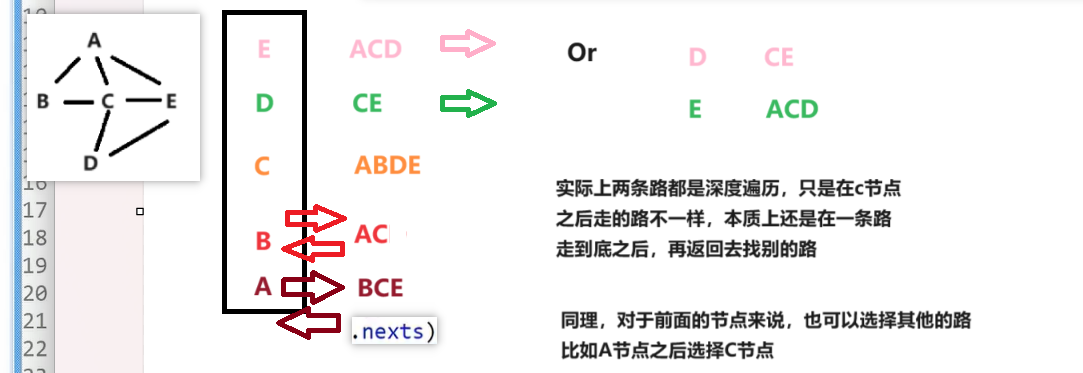图:由点的集合和边的集合组成。
常用的表示图的方法有两种:
1、邻接表法
将一个点的邻居都列出来。有向图只列出从这个点出发向外发散的点

2、邻接矩阵法
将点集列出一列行,列出一列列,在矩阵中填两点之间的权值(距离)

【精选】数据结构:图(Graph)【详解】_数据结构图_UniqueUnit的博客-CSDN博客
解图有关的题目的思路:
图有很多表达方式,我们通常都是 先将图转化为熟悉的表达方式,再实现算法
图结构模板
package graph;import java.util.ArrayList;
import java.util.HashMap;
import java.util.HashSet;public class Graph {public HashMap<Integer, Node> nodes;//点集:编号、点public HashSet<Edge> edges;//边集:边public Graph() {nodes = new HashMap<>();edges = new HashSet<>();}}class Node {public int value;//数据public int in;//入度public int out;//出度public ArrayList<Node> nexts;//对有向图,从当前这个点出发发散的直接邻居的点public ArrayList<Edge> edges;//对有向图,发散出去的边属于这个点,指向进来的边则不属于这个点public Node(int value) {this.value = value;in = 0;out = 0;nexts = new ArrayList<>();edges = new ArrayList<>();}
}class Edge {public int weight;//权值public Node from;//边的起点public Node to;//边的终点public Edge(int weight, Node from, Node to) {this.weight = weight;this.from = from;this.to = to;}
}
其他图的方式转化为此结构示例
原来的表达方式
| 权值weight | 始节点from | 末节点to |
| 5 | 0 | 1 |
| 3 | 1 | 2 |
| 7 | 0 | 2 |
package graph;public class Transmit {//matrix矩阵,n*3,[weight,from,to]public static Graph creatGraph(Integer[][] matrix) {Graph graph = new Graph();for (int i = 0; i < matrix.length; i++) {//遍历每组数据Integer weight = matrix[i][0];Integer from = matrix[i][1];Integer to = matrix[i][2];if (!graph.nodes.containsKey(from)) {//没有from节点graph.nodes.put(from, new Node(from));//创建from节点,加入到图的点集之中}if (!graph.nodes.containsKey(to)) {//没有to节点graph.nodes.put(to, new Node(to));//创建to节点,加入到图的点集之中}Node fromNode = graph.nodes.get(from);Node toNode = graph.nodes.get(to);fromNode.nexts.add(toNode);//加入到from的nexts集合中fromNode.out++;//fromNode出度++toNode.in++;//toNode入度++Edge edge = new Edge(weight, fromNode, toNode);//创建边graph.edges.add(edge);//加入到图的边集fromNode.edges.add(edge);//加入到fromNode点的边集中}return graph;}
}

图的遍历的注意点:二叉树无环、图有环(避免图的环导致代码死循环)
宽度遍历:一层一层向下遍历,先遍历距离A最近的点,再遍历距离A隔了一层的节点
深度遍历:一条路走到死,再返回去看还有哪条路可以走

图的宽度遍历
如果确定节点的类型为数字,可以将哈希表写成数组结构用索引查找,可以节省时间
package graph;import java.util.HashSet;
import java.util.LinkedList;
import java.util.Queue;public class Traversal {public static void widthTraversal(Node node) {if (node == null) {return;}HashSet<Node> hashSet = new HashSet();//放一个set防止重复把节点丢到队列里造成死循环Queue<Node> queue = new LinkedList();hashSet.add(node);queue.add(node);while (!queue.isEmpty()) {Node node0 = queue.poll();//从队列中弹出System.out.println(node0.value);//打印or执行操作for (Node node1 : node.nexts) {//遍历node的nexts的点集中的所有的点if(!hashSet.contains(node1)){//判断是否在set里面,是否出现过,防止环形结构死循环hashSet.add(node1);//如果没有,就放入set和队列中queue.add(node1);}}}}}
图的深度遍历

public static void deepTraversal(Node node) {if (node == null) {return;}HashSet<Node> hashSet = new HashSet();//放一个set防止重复把节点丢到队列里造成死循环Stack<Node> stack = new Stack();hashSet.add(node);stack.add(node);System.out.println(node.value);while (!stack.isEmpty()) {Node node0 = stack.pop();for (Node node1 : node0.nexts) {if(!node0.nexts.contains(node1)){stack.push(node0);//node再重新入栈stack.push(node1);//邻居入栈hashSet.add(node1);//入set集合System.out.println(node1.value);break;}}}}
】)



~持续更新)



-34)







![[NLP] LlaMa2模型运行在Mac机器](http://pic.xiahunao.cn/[NLP] LlaMa2模型运行在Mac机器)

学习笔记----层次式架构设计理论与实践)